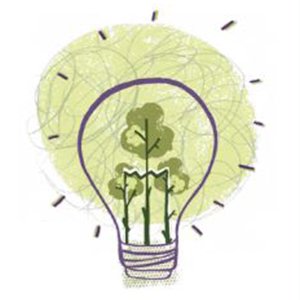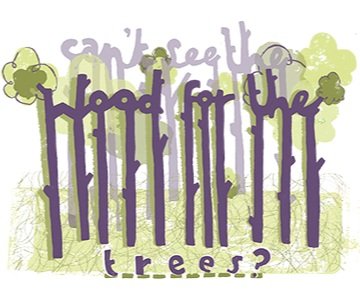49% of consumers believe organisations promoting digital as better for the environment is really about saving cost.
Greenwashing is any misleading claim that one product or service is more sustainable or has less impact on the environment than another. One of the products that has been the target of a good deal of greenwashing is paper.
In 2020-2021, Two Sides’ successful global campaign to contact companies making false claims about paper’s environmental impact saw over 800 companies remove such information from their marketing.
We’ve busted a few myths for you, including a common claim many companies make that going paperless is better when their actual goal is to save money by replacing recyclable, sustainable paper with digital communication that carries a larger carbon footprint.
Paper is made from wood, one of the most sustainable materials on the planet.
It’s a renewable resource that captures and stores carbon, is biodegradable and can be recycled seven times.
No other material can do that.
More paper means more trees
The paper manufactured in Australia mainly comes from managed regrowth or planted forests where the cycle of planting, growing and harvesting is carefully controlled. The Australian paper and pulp industry is growing trees, and that’s great for the environment.
A healthy market for forest products such as paper encourages the long-term growth of forests through sustainable forest management which helps to mitigate climate change by absorbing CO2.
The Australian Forest industry plants around 70 million plantation trees every year, covering an area equivalent to 136,000 football fields.
Between 2005 and 2020, European forests, which provide 90 per cent of the virgin wood fibre used by the European paper industry, grew by 58,390 km2 – an area bigger than Switzerland and amounts to 1,500 football pitches of forest growth every day (United Nations FAO, 2020).
The paper industry is a low greenhouse gas emitter
The Pulp Paper Industry is one of the smallest greenhouse gas (GHG) emitters of the major industry sectors on the planet, responsible for just 1.1 per cent of the world's GHG emissions and only 0.8% of total national emissions in Australia (Australian Forest Products Association’s paper, Pulp & Paper Sector Status as an Emissions Intensive and Trade Exposed Industry, page 4, April 2022).
To give that some context, the same amount of CO2 is used per year by all mail delivered to an average household versus a coffee maker being on for one hour per day.
The same amount of CO2 is used per year by all mail delivered to an average household in a year versus a coffee maker being on for one hour per day for one year.
Swedish Royal Institute for Technology; Paper & the Environment, ATS Consulting 2007 Life Cycle Inventory of the Mail; Greening the Mail Taskforce, 2008
Paper is one of the most recycled products in the world.
We’re fortunate to live in one of the leading countries in the use of recycled paper. More than half of all fibre used in Australia to make paper now comes from recycled material (Australia's Wood and Paper Industry, Nov 2019) and our recovery of paper products is now at 60% (National Waste Report 2018). Australia’s Environment ministers have endorsed a national target of 100% of packaging designed to be reusable, recyclable or compostable by 2025.
Paper made from sustainable forests is needed to start the paper cycle. Recycled fibre degrades after several uses and the paper industry needs fresh fibre from responsibly managed forests to keep the renewable cycle going. So get on board. The future is coming and paper’s going to be a big part of it.
"To address climate change, we must use more wood, not less.
Using wood sends a signal to the marketplace to grow more trees and to produce more wood.
Trees are the only abundant, biodegradable and renewable global resource.”
Dr. Patrick Moore, co-founder of Greenpeace.
How much paper production is old forests?
There’s a lot of misinformation about this issue. Australian forests are far more protected than it would seem from media hype. See this recent article, Forestry facts rather than furphies, published by the Tasmanian Minister for Resources about protests in Tasmania for a more balanced and excellent overview of the actual situation in Australia.
Australia’s plantations currently account for more than half of our production of wood and paper products in Australia and will be the source for much of the further growth of the wood and paper industry in Australia. There are currently 1.1 million hectares of plantations in Australia. The expansion of these plantations is a key goal of the National Forest Policy Statement (NFPS) and the Federal Government's Wood and Paper Industry Strategy.
Over 90% of Australia’s commercial native forest operations are independently certified to comply with the world’s best sustainable forest management practices. This is compared to the global average of 8%, making Australia a leader in ensuring the sustainability of forest practices (Australia's State of the Forests Report 2018).
What is the print industry doing about its environmental responsibilities?
It’s a big issue that will take time to address, but the print industry is active in making positive steps towards sustainability. Many brands in the sector have already committed to the eco-friendlier alternative and are developing recycled papers that replicate the bright white quality of conventional paper—making the use of recycled paper more feasible and attractive to the consumer.
For more information, you can download Two Sides’ paper, Go Green Go Paperless Messages are Misleading.







